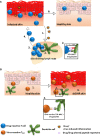Skin Resident Memory T Cells May Play Critical Role in Delayed-Type Drug Hypersensitivity Reactions
- PMID: 34497600
- PMCID: PMC8419326
- DOI: 10.3389/fimmu.2021.654190
Skin Resident Memory T Cells May Play Critical Role in Delayed-Type Drug Hypersensitivity Reactions
Abstract
Delayed-type drug hypersensitivity reactions (dtDHR) are immune-mediated reactions with skin and visceral manifestations ranging from mild to severe. Clinical care is negatively impacted by a limited understanding of disease pathogenesis. Though T cells are believed to orchestrate disease, the type of T cell and the location and mechanism of T cell activation remain unknown. Resident memory T cells (TRM) are a unique T cell population potentially well situated to act as key mediators in disease pathogenesis, but significant obstacles to defining, identifying, and testing TRM in dtDHR preclude definitive conclusions at this time. Deeper mechanistic interrogation to address these unanswered questions is necessary, as involvement of TRM in disease has significant implications for prediction, diagnosis, and treatment of disease.
Keywords: Stevens-Johnson syndrome; adverse drug reactions; delayed-type drug hypersensitivity reactions; drug reaction with eosinophil and systemic symptoms; fixed drug eruption; maculopapular exanthem; tissue-resident memory T cells; toxic epidermal necrolysis.
Copyright © 2021 Schunkert, Shah and Divito.
Conflict of interest statement
The authors declare that the research was conducted in the absence of any commercial or financial relationships that could be construed as a potential conflict of interest.
Figures

Similar articles
-
Systemic and skin-limited delayed-type drug hypersensitivity reactions associate with distinct resident and recruited T cell subsets.J Clin Invest. 2024 Jul 23;134(17):e178253. doi: 10.1172/JCI178253. J Clin Invest. 2024. PMID: 39042477 Free PMC article.
-
The Roles of Immunoregulatory Networks in Severe Drug Hypersensitivity.Front Immunol. 2021 Feb 26;12:597761. doi: 10.3389/fimmu.2021.597761. eCollection 2021. Front Immunol. 2021. PMID: 33717075 Free PMC article. Review.
-
In vitro diagnosis of delayed-type drug hypersensitivity: mechanistic aspects and unmet needs.Immunol Allergy Clin North Am. 2014 Aug;34(3):691-705, x. doi: 10.1016/j.iac.2014.04.009. Immunol Allergy Clin North Am. 2014. PMID: 25017686 Review.
-
Delayed-type hypersensitivity reactions induced by proton pump inhibitors: A clinical and in vitro T-cell reactivity study.Allergy. 2018 Jan;73(1):221-229. doi: 10.1111/all.13235. Epub 2017 Jul 30. Allergy. 2018. PMID: 28658503
-
Pathophysiology of Skin Resident Memory T Cells.Front Immunol. 2021 Feb 3;11:618897. doi: 10.3389/fimmu.2020.618897. eCollection 2020. Front Immunol. 2021. PMID: 33633737 Free PMC article. Review.
Cited by
-
Updates in the pathogenesis of SJS/TEN.Allergol Int. 2025 Jul;74(3):361-371. doi: 10.1016/j.alit.2025.05.002. Epub 2025 Jun 4. Allergol Int. 2025. PMID: 40473510 Free PMC article. Review.
-
HIV-Associated Immune Dysregulation in the Skin: A Crucible for Exaggerated Inflammation and Hypersensitivity.J Invest Dermatol. 2023 Mar;143(3):362-373. doi: 10.1016/j.jid.2022.07.035. Epub 2022 Dec 20. J Invest Dermatol. 2023. PMID: 36549954 Free PMC article. Review.
-
Heterogeneity and plasticity of tissue-resident memory T cells in skin diseases and homeostasis: a review.Front Immunol. 2024 May 8;15:1378359. doi: 10.3389/fimmu.2024.1378359. eCollection 2024. Front Immunol. 2024. PMID: 38779662 Free PMC article. Review.
-
Immune checkpoint inhibitor-induced severe epidermal necrolysis mediated by macrophage-derived CXCL10 and abated by TNF blockade.Nat Commun. 2024 Dec 30;15(1):10733. doi: 10.1038/s41467-024-54180-7. Nat Commun. 2024. PMID: 39737932 Free PMC article.
-
Practical Implementation of Genetics: New Concepts in Immunogenomics to Predict, Prevent, and Diagnose Drug Hypersensitivity.J Allergy Clin Immunol Pract. 2022 Jul;10(7):1689-1700. doi: 10.1016/j.jaip.2022.04.027. Epub 2022 May 6. J Allergy Clin Immunol Pract. 2022. PMID: 35526777 Free PMC article.
References
-
- Velasco-Tirado V, Alonso-Sardon M, Cosano-Quero A, Romero-Alegria A, Sanchez-Los Arcos L, Lopez-Bernus A, et al. . Life-Threatening Dermatoses: Stevens-Johnson Syndrome and Toxic Epidermal Necrolysis. Impact on the Spanish Public Health System (2010-2015). PloS One (2018) 13(6):e0198582. 10.1371/journal.pone.0198582 - DOI - PMC - PubMed
Publication types
MeSH terms
Grants and funding
LinkOut - more resources
Full Text Sources
Medical

